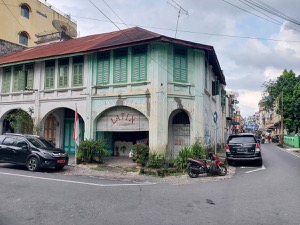Pematangsiantar (also known as Siantar) is city in North Sumatra Province of Indonesia, and it’s the second-largest city in North Sumatra after Medan.
Siantar not a city on the tourist trail, but I ended up here on the way back from Lake Toba to Medan. There is a train from Siantar to Medan, and I have written a guide on how to get the train and bus from Medan to Lake Toba via Siantar.
If you are travelling from Lake Toba to Medan, then the most sensible option is to get the bus. If you still persist on getting the train and bus combo, then here is what to see and do in Siantar.
Siantar is best described as a provincial market city. While Parapat is the main market town of Lake Toba, Siantar is the closest big city to the lake.

Whenever I am in a new city, I usually head to the central market first and work my from there.

Siantar’s population is a slight majority of Batak christians, and there is Batak-style architecture in the city.

The population of North Sumatra is mostly muslim, see there is a blend of churches and mosques in the city.

[Taqwa Muhammadiyah Mosque.]
City parks are another good target to walk to when you don’t know what else to do, so I walked to the Pematangsiantar City Flower Park.

[Pematangsiantar City Flower Park.]
One of the musuems in the city is the Museum Simalungan Pematangsiantar, which is dedicated to Simalungun Batak culture.

[Museum Simalungan Pematangsiantar.]
There was Dutch presence here in the colonial era, but like most Indonesian cities, there is very little colonial-era architecture that remains.

There are some old shophouses scattered around the centre of the city.

Even without the old buildings, the old city area still has smaller streets that are walkable and more conducive for lively cafes and restaurants.

[Kok Tong Kopi in Siantar.]
Some of these smaller streets should experiment with full or partial pedestrianisation.

I had just spent over a week on Lake Toba, so Siantar felt chaotic after the peaceful lakeside life. After a few hours of readjustment I got my city legs back, and I found that Siantar is more orderly than your average provincial Indonesian city.

I marked some potential cafes to visit, which made for good walking goals. Walking to Brew Brother took me through a nice suburban area of the city.

[Brew Brother Pematangsiantar]
Another cafe to visit is Soeaka Cafe, opposite the train station. The train I was taking the next day was scheduled to depart before sunrise, so I went to the station to get some photos. The station is in the town centre so it’s easy enough to walk to.

[Pematangsiantar Station.]
Soeaka Cafe is a great cafe to visit even if you are not getting the train.

[Soeaka Cafe.]
The cafe is not open when the morning train departs, so I had a coffee and imagined a day when there are more train services. There are plans to extend. the railway to Lake Toba, so who knows, maybe this will be a more lively station in the future.

[Soeaka Cafe station view.]
Near this cafe is the most splendid urban tree in Pematangsiantar.

There is a good night market at Jl. Vihara in the city centre, so that was an easy choice for dinner.

[Jl. Vihara night market.]
After Siantar I got the train back to Medan, which is home to the biggest station in the Sumatra rail network. I spent another day in Medan before getting the train from Medan to Kualanamu Airport.
